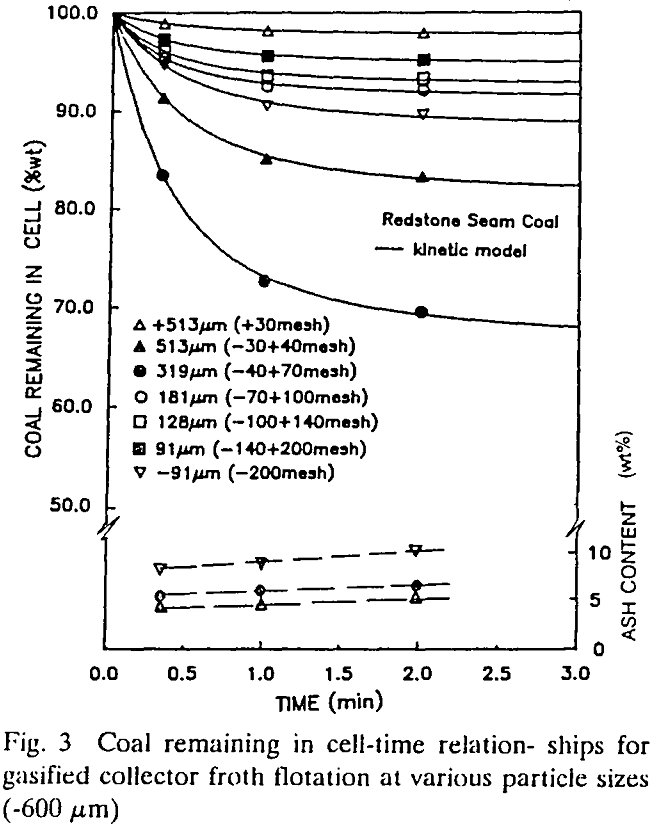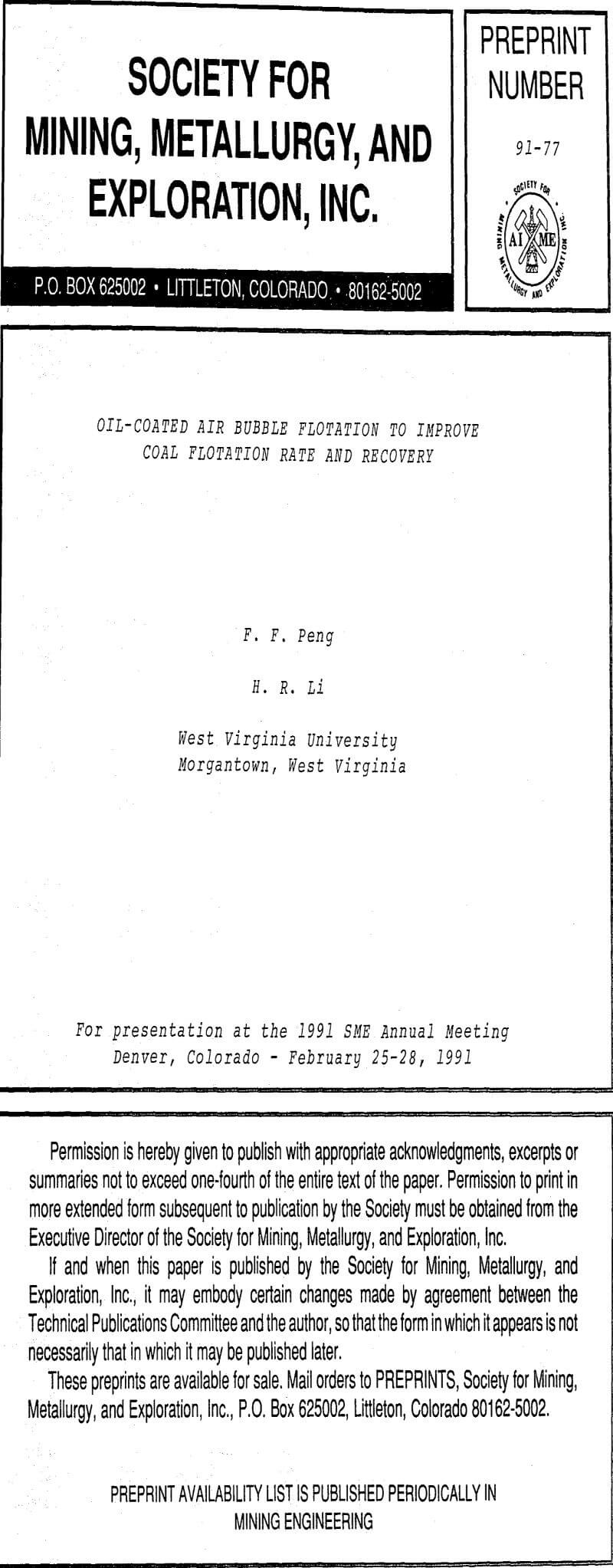Table of Contents
A unique collector dispersion techniques was developed and used to improve the flotation rate and recovery of coarser and ultrafine coal-rich particles in the froth flotation processes. In this novel collector dispersion method, the collector such as hydrocarbon-oil is gasified and transported by gas phase (air stream) into the pulp. In addition to the excellent mode of collector dispersion, the collector-encapsulated air bubbles are generated in the pulp. This approach alters the surface properties of air bubbles and provide the fast rate of flotation compared to that of direct liquid collector addition froth flotation.
Most of the coal fines -600 µm (-30 mesh) are commonly treated by the froth flotation process using a bank of stirred tank cells. In a conventional practice of a froth flotation operation, coal fines, the liquid form of frother, the collector such as kerosene or fuel oil, and/or a conditioner are mechanically stirred in a water solution. Then, the air bubbles are introduced into the pulp. The coal-rich particles, being naturally or induced hydrophobic, will adhered to the air bubbles.
Froth Flotation Techniques
One of the problems associated with floating the ultrafine coal in conventional froth flotation is the slow flotation rate. Another problem is that the fine coal often contains large amounts of ultra fine clay minerals which are easily carried into the froth product by hydraulic entrainment. As a result, low throughput and high ash values in the product are commonly obtained when conventional froth flotation process are used to treat micronized or ultra fine coal.
The recovery of larger size coal particles by froth flotation techniques has been developed by the Broken Hill Proprietary (BHP) Central Research Laboratories in Australia. Physical and chemical variables effects on coarse coal flotation have been extensively studied. The studies by BMP reveal that froth structure and mobility are major factors limiting the coarse coal recovery. Froths produced by coarse coal flotation are dense and often immobile.
In the froth flotation process, whether accomplish in a conventional stirred tank flotation cell, in a column flotation cell, in an air sparged cyclone flotation or in a static-tube cell by using microbubbles, it requires the addition of surfactants and/or reagents such as frother and/or collector (or promotor). These reagents in liquid forms are directly added into the coal pulp in froth flotation systems. Frequently, a conditioning tank is required to achieve the dispersion of the reagents.
Experimental
The air-dried raw coal sample was crushed in a jaw crusher and a double roll crusher. These crushed raw coal samples were then sieved to obtain two sets of samples including -1.7 mm (-12 mesh US sieve) and -600 µm (-30 mesh US sieve) coal samples. The prepared raw coal samples were stored individually in sealed polyester bags.
Kerosene was used as the collector and MIBC (mehthyl isobutyl carbinol) was used as frother throughout this study, although any other light hydrocarbon oil and frother may be selected for the study. The selection of kerosene and MIBC were mainly for their being most the commonly used collector and reagent in conventional froth flotation.

The semi-batch froth flotation tests were conducted using gasified collector dispersion and direct liquid addition techniques. For all the tests, 100 g of raw coal sample and 900 ml of distilled water were added to a 1000 ml size stainless steel flotation cell to make a 10 % solids pulp (moisture of raw coal is 0.9 % wt.).

Results and Discussion
The bubble attachment time is considered as the time required for rupture and displace the water film between the solid and gas phases. Thus, the fundamental physico-chemical factor which determines the behavior of flotation separation process is the relative magnitude of bubble attachment time and the contact time between solid and gas phases. The contact time is solely determined by nature of collision events, and is fixed for a specified type of flotation system. The bubble attachment time on the coal surface, thus, becomes a major factor which can be altered to achieve selective flotation separation. Therefore, many published work centered on altering the bubble attachment time by modifying the hydrophobicity of coal or pyrite using adsorption of specific reagents
When the mixture of gasified collector and air is dispersed into a flotation cell, the hydrocarbon-oil is coated on the surface of air bubbles. Therefore, the gasified collector transported by air into a flotation cell provide an excellent way of collector dispersion. It has been known that the London and van der Waals attractive forces are more favorable for a hydrocarbon-oil encapsulated bubble (Burin and Branmley, 1961; Vincent, 1973) than oil-free bubbles.

The rate of flotation is governed very largely by the time available for attachment to occur (nature of collision events) and bubble attachment time between solid and gas phases in the aerated pulp. Accordingly, the rate of coal flotation is proportional to the hydrophobicity and concentration of coal particles as well as the surface – properties of bubbles and the availability of air bubble surface area per unit volume of pulp.
Another problem in cleaning coal fine with direct liquid collector addition froth flotation is the lack of selectivity. In the LCF for raw coal with a high content of middling particles, the ash content of the clean coal product will be rather high. On the contrary, for raw coal with low content of middling, the ash content of clean coal product will be low. In both cases, no significant difficulty will be encountered in the separation operation. It is because that the process conditions in the LCF is to separate both middling and coal-rich particles from high ash particles which are very different in floatability (or bubble contact time).
In order to investigate the interrelationship between coal particles and oil-coated air bubbles, the experimental results were correlated with coal particle size distribution. The clean coal products obtained at various flotation time were sieved for size distribution and analyzed for ash content in each size fraction.






An overall increase in the flotation rate of the intermediate size range is due to the strong attachment between air bubbles and particles with hydrophobic sites. Both the entrainment and the flotation mechanism are responsible for the enhanced flotation in the intermediate size range.
The flotation rate of the ultrafine size range decreases as the particle size decreases. The decrease in floatability in the ultrafine size range is due to decreased probability of colliding between air bubbles and ultrafine coal particles.
